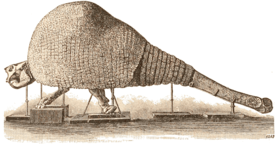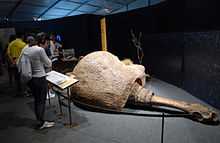Doedicurus
| Doedicurus Temporal range: Pleistocene - Holocene, 0.781–0.011Ma | |
|---|---|
 | |
| Illustration of a skeleton | |
| Scientific classification | |
| Kingdom: | Animalia |
| Phylum: | Chordata |
| Class: | Mammalia |
| Superorder: | Xenarthra |
| Order: | Cingulata |
| Family: | †Glyptodontidae |
| Genus: | †Doedicurus Burmeister, 1874 |
| Species: | †D. clavicaudatus Owen, 1847 |
| Binomial name | |
| Doedicurus clavicaudatus Owen, 1847 | |


Doedicurus clavicaudatus was a prehistoric glyptodont, living during the Pleistocene until the end of the last glacial period, some 11,000 years ago. This was the largest known glyptodontid, and one of the better-known members of the New World Pleistocene megafauna, with a height of 1.5 meters (5 ft) and an overall length of around 4 meters. Doedicurus could reach a mass of 1,910 to 2,370 kg.[1] It had a huge domed carapace that was made of many tightly fitted scutes, somewhat similar to that of its modern-day relative, the armadillos. Its tail was surrounded by a flexible sheath of bone and had long spikes or knobs on the end, at least in male individuals.[2]
D. clavicaudatus inhabited woodlands and grasslands and was herbivorous. Its tail club was probably used in intraspecific conflict rather than defense against predators like Smilodon unlike the superficially similar club of the Ankylosaurs. For one thing, the latter use would have been difficult since the animal's field of vision was so limited that it would essentially have had to blindly thrash the tail club. In addition, carapaces have been found which show fractures that were produced by roughly the same amount of energy as could be produced by the tail muscles.[2]
Its name means "pestle tail", referring to how, if the spikes were removed, it would resemble a pestle.
The carapace was firmly anchored to the pelvis but loose around the shoulder. Its front bore an additional smaller dome. This has been interpreted as a fat-filled space, similar to a camel's hump, which would have stored energy for the dry season and cushioned blows of the tail of rival animals.[2]
Fossils of D. clavicaudatus are found in North America and South America, especially the Ensenada Formation in Argentina. Given the late date of its disappearance, it was encountered and probably also hunted by the first human settlers of South America.
Notes
References
- ↑ http://www.sbpbrasil.org/revista/edicoes/15_1/9_Soibelzon_et_al.pdf (in spanish)
- ↑ 2.0 2.1 2.2 Alexander, R. M.; Fariña, R. A.; Vizcaíno, S. F. (May 1999). "Tail blow energy and carapace fractures in a large glyptodont (Mammalia, Xenarthra)". Zoological Journal of the Linnean Society 126 (1): 41–49. doi:10.1006/zjls.1997.0179.
| Wikimedia Commons has media related to Glyptodontidae. |